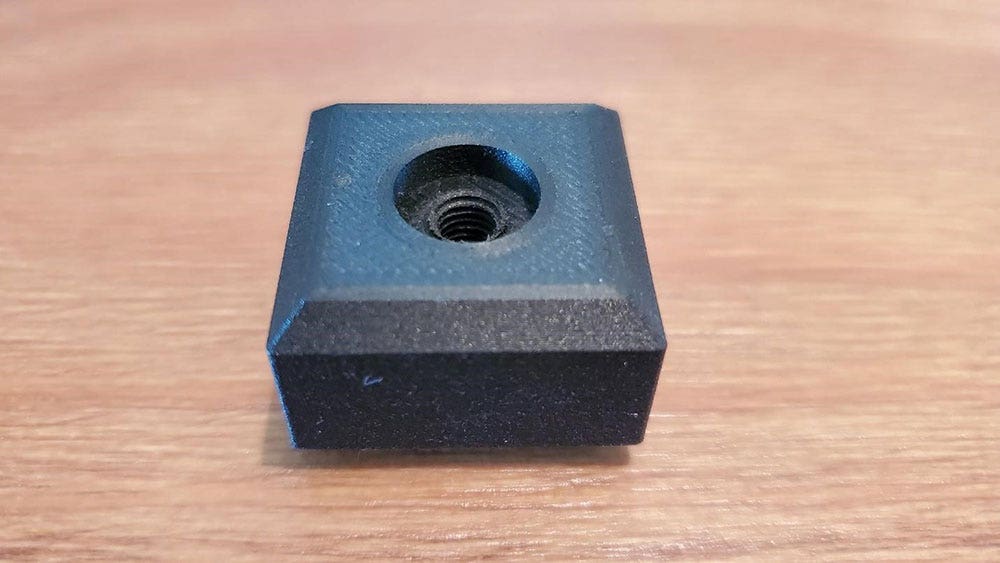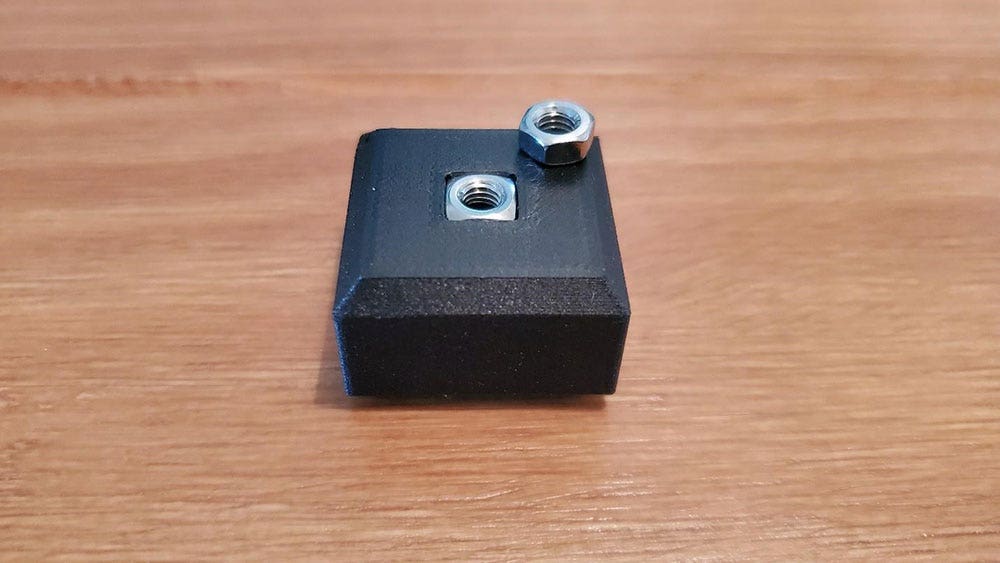In a previous post titled “Getting the Most out of Your Markforged Composite 3D Printer,” we looked at a few tips and tricks that can be used to enhance parts that are printed with Markforged systems.
In today’s blog, we’ll be going over several different options that can be used to add threads to 3D printed parts, as well as the strengths and weaknesses of each method.
Metal and Composites
Here are a few options for adding threads to both either metal or composite materials.
Printed Threads
When it comes to adding threaded features to 3D printed parts, the obvious choice would be to simply print the threads themselves. After all, Markforged printers are extremely accurate, with both metal and composite printer lines able to print extremely small threaded features.

An example of a small threaded feature printed on a Markforged Metal X.
The angle of many threads is usually very steep, however, and larger teeth may need support material. This can result in a small amount of post-processing before threads are usable. On the composite side, plastic threads that repeatedly interface with metal can also result in premature wear. As a result, composite threads are usually best for more permanent placements.
Strengths
- Custom geometry
- Integrated into design/no additional hardware
Shortcomings
- Potential removal of supports
- Composite threads aren’t as long-lasting with repeated use compared to metal
Tapped Threads
Rather than printing threads, another option would be to tap threads into a part after it is printed. This would be a valid choice for both metal and composite systems. Eiger also offers the ability to increase the number of solid walls in 3D printed parts, meaning that a feature designed for tapping will present minimal risk of exposing infill while it is being post-processed.

Tapped threads are great for both metal and composite 3D printed parts.
Strengths
- As accurate as the tools being used
- Can save time during the design phase
Shortcomings
- Additional hardware required (taps)
- Composite threads aren’t as hard as metal
Composites
Below are some of the threading options for composite materials.
Heat Set Inserts
For composite and plastic only parts, one of the most common methods of adding threads to parts is using heat-set inserts that were specifically designed for 3D printing. These include brass inserts such as those found on McMaster-Carr. The ridges and teeth found on these inserts help to lock them into place once they are set into the plastic matrix. As a result, heat-set inserts are usually one of the strongest threaded options available.

Heat set inserts designed for plastic parts provide high strength and durability.
Strengths
- Custom ridges/teeth yield high-strength bonds
- Can save time during the design phase
- Reusable threads that last much longer than plastic
Shortcomings
- Additional hardware required
- Incorrect heat settings can lead to improper placement
Press-Fit Inserts
As the name implies, press-fit inserts are simply placed into a custom cavity after a part is printed. Depending on tolerances and part requirements, this can be done by hand or with external hardware if the fit needs to be tighter. Many other insert types such as dowel pins can be press-fit into 3D printed parts to add additional functionality at low cost.

A wide range of hardware options can be press-fit into 3D printed parts. The square nut pictured above is pressed into the bottom face of our example part.
Strengths
- Quick and easy to install
- Many different types of inserts can be press-fit
Shortcomings
- Extremely low tolerances may require hardware to physically place insert
Captive Inserts
The Markforged Eiger software allows users to pre-emptively set a pause during their print jobs at specific layers. In terms of threaded inserts, a user can design a cavity for their hardware and insert said hardware during a pause. Once the component has been inserted, the user can resume a print job and allow the component to be over-printed.
A video showing how captive inserts can be applied on a Markforged machine.
In comparison to press-fit inserts, a captive threaded component could be reinforced on all sides by internal fibers. Captive components also have no risk of accidentally being removed from a part. Layers that are cooled too much can potentially not bond as well to fresh layers, however, so timely user intervention is recommended during a paused print.
Strengths
- Various types of components can be integrated
- Cannot be removed
- No hardware beyond the inserts is required
Shortcomings
- User attention is required during a pause
- Improper placement can cause issues
Tapping Inserts
As mentioned earlier, printed composite threads are usually recommended for more permanent applications, rather than for hardware that will be removed multiple times. This final category can work in conjunction with printed threads, allowing users to both print threads and provide a metal interfacing surface for their hardware.

An example of one type of tapping insert.
Strengths
- Provides a metal to metal interface
- Simple installation
Shortcomings
- Larger than intended threads needed in the design
- Modeling functional threads adds to design time
If threads are already part of a design, this can be a great option to add strength and longevity to threaded features.
Thanks for reading everyone! Check out our site for more information on Markforged 3D printers, and if you have any questions be sure to contact us at Hawk Ridge Systems today.




